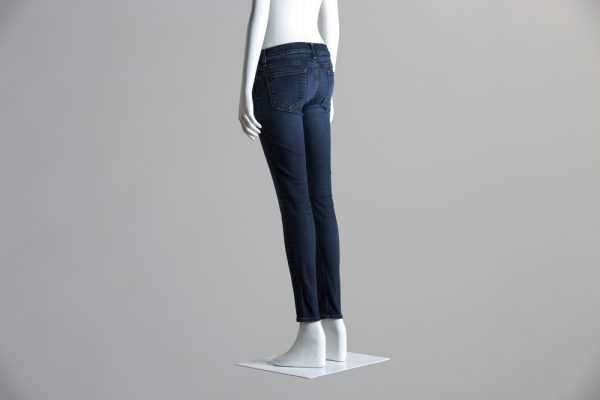For the most part, we tend to keep our clothes relatively clean and avoid spills and rips and tears. But denim is so hard-wearing and hard-working that it just kind of amasses more and more signs of wear. So you can learn a lot from observing an old pair of blue jeans.
Articles of Interest is a show about what we wear; a six-part series within 99% Invisible, looking at clothing. Episodes will be released on Tuesdays and Fridays from September 25th through October 12th.
For Denim, Avery Trufelman spoke with her friend, artist and curator Lukaza Branfman-Verissimo; Tracey Panek, the corporate historian at Levi Strauss and Company; Lynn Downey, a biographer of Levi Strauss and the former Levis corporate historian; Ada Kong, the toxics manager at Greenpeace East Asia; Emma McClendon associate curator of costume at The Fashion Institute of Technology; Ulrich Simpson, owner of the small independent denim brand UBI-IND.






Comments (10)
Share
99% Awesome. Thanks!
Where can I find the audio for Sasami Ashworths outro song? The one that says “there’s a portrait painted on the things we love?” It’s so magical. I can’t find it anywhere. If I can get just an audio clip that would make my day. Thanks!!!
Wow. Amazing episode, guys. Why didn’t you list Anne Masai in the show notes?
There’s a link to her story down there if you want to check it out!
I graduated high school in 1974. When I was a teenager, the jeans were is blue as night and a stiff as a board when they came from the store. It would take several weeks of geeky wearings, not to mention driving over them with my 1970 VW van, before they faded and became a beautiful and favored garment, the likes of which I haven’t seen since the 70s. Now I know why.
I would love to be able to download or even just stream that outro song by Sasami Ashworth. At the very least I would like to share it with a friend of mine. Thanks for another awesome episode, by the way.
Full song is now embedded on 99pi.org/aoi !
You touched on how synthetics have worked their way into our modern jeans and how plastics are not good in there.
You could even go biblical with Leviticus …”Do not wear clothing woven of two kinds of material.” Good luck with that one these days!!
My gripe is with the durability. I don’t need lycra-blended jeans for stretchiness and conform. I need jeans that will last. The issue with “real” jeans with “real” Denim is they are thick, heavy and hot. Modern jeans are becoming thinner, lighter and cooler. The issue though, is I will wear them out to the point where I can simply grab any sections of the pants and rip any section of the denim out with my hand. Trying to patch them is not possible because the whole leg is worn thin and a patch would not stay. Its almost as if all the cotton has been washed out of them. These new modern jeans last me about a season before they are too beat up to be appropriate for wearing to work.
Great show though. I have been really enjoying them! Keep it up!
If there are any thoughts on continuing this series:
How about an episode on sizes? – clothes and shoes, women’s sizes vs. men’s sizes (why is a size 7 shoe different in men’s and women’s, why are women’s pants sizes in Arabic numbers instead of waist sizes like men’s [I can probably guess the answer to that one!]), US sizing vs. European sizing, how do other countries size clothes, etc.
And maybe an episode on making one’s own clothes – how one learned to sew (home ec classes vs. taught by mother/grandmother), patterns, cost now vs. cost over the decades (both fabric and patterns), county/state fair and 4H competitions, etc.
I’d love to hear the discussion on how history is reflected in the clothing we wear. There was an interesting allusion to how what we may wear may in effect determine the opinion that someone may have of us or our ability to fit within expected norms.
I’ve thought about this quite a bit over the last two years as I’ve gone from wearing suits daily as a management consultant to a casual, hiking-ready outfit on a daily basis. (Full disclosure: the spark for this change came 10 months ago when my nine year old son asked me: “why do you wear a suit to work?”…I dumbfoundedly responded with “I don’t know…” and stopped wearing suits) Couple this with the long hair that’s grown in the last year and I suppose I’m making quite a statement!
What I’m most interested to hear is a discussion about diversity and inclusion and the role that clothing plays in conforming groups to a standard across many walks of life. Work is a great example because it’s full of case studies, but religious institutions and educational environments provide good backdrops too (I believe an episode hinted at athleisure-wear taking hold by way of college campuses).
If we can’t wear what we want to work, are we bringing our authentic self? If we feel like conformity drives the first decision we make in the morning five days a week, are we really thinking our mind is free to think beyond the obvious when facing challenges? Clothing for all its lovely warmth and individuality or belonging and general fun, can be oppressive when left up to unchecked norms in our lives.
I love the thread that this podcast pulls…please continue to pull!